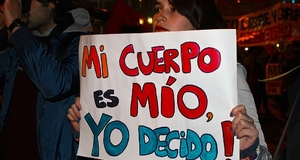Free Speech and Abortion Clinics: Protesters, Security, and Patients' Rights
By
2012, Vol. 4 No. 03 | pg. 2/2 | « Drawing the LineIn order to determine where to draw the line between protected speech and unprotected speech/harassment at abortion clinics, it makes sense to individually examine sevearal of the forms of speech identified in the National Abortion Federation’s report: picketing, picketing with blocking or contact, vandalism, bomb threats, and posting of patient pictures on the Internet.21 PicketingSimple picketing – which may include prayer, singing, shouting, or holding signs or objects – is the simplest and most clearly protected form of speech on this list. Even when protesters hold up gory photographs of bloody stillborn fetuses22 claiming that they are showing abortion outcomes, they are well within their rights of free speech regardless of the discomfort they may cause others. Much like privacy expert Daniel Solove said of the Snyder v. Phelps litigation, these protests are the very kind of political “unpopular speech that the Constitution protects.”23 Picketing with Blocking or Contact (Sidewalk Counseling)This is the blurriest of the five speech categories presented here. We have already established that protesters have the right to speak loudly in many ways in front of abortion clinics. However, when those protesters start establishing direct contact with patients and visitors, one must wonder whether those people have a right not to hear what the protesters have to say.This would be a more straightforward question to answer if clinic visitors were not participating in their own constitutionally protected activity – seeking an abortion, contraception, or other reproductive health services, as they have the right to do under constitutional privacy doctrine.While this doctrine prohibits the government from instituting an (increasingly nebulous) “undue burden” on these individuals, it does not necessarily require the government to protect them from other private citizens attempting to do the same thing. Yet the passage of the FACE Act and local buffer zone laws suggest that the government has taken on that responsibility, at least in certain situations. The answer here seems to be a careful application of the law as it is written. Those jurisdictions with buffer zone laws have a much clearer (literal) line that protesters cannot cross, and that helps guarantee that everyone knows what their rights are and can act freely within them. In the vast majority of jurisdictions without these clear laws, however, it is unclear where the line is between free speech and harassment, between trying to start a conversation and illegally disrupting access. In these situations, the FACE Act and other laws (such as those prohibiting harassment or stalking) must be carefully used to ensure that the law is either imposing an appropriate time, place, and manner restriction or correctly prohibiting an illegal action. VandalismAs an illegal form of damage to private property, vandalism is clearly beyond the scope of the First Amendment’s protections. Though there may be legitimate arguments for some forms of vandalism (specifically graffiti) as a protected free speech act on public property, the defacing of a private clinic would seem to be well outside the realm of reasonable argument. Vandalism also covers a wide array of actions that could be defined as speech but are primarily malicious acts of destruction; the Feminist Majority Foundation considers vandalism to include broken windows, tampering with dumpsters and phone lines, leaving nails or motor oil in driveways and parking lots, gluing locks, or damaging the homes or personal property of clinic staff, as well as graffiti.24 These actions are too destructive to be protected speech under the First Amendment, and are rightfully prohibited by general local laws as well as the FACE Act. Bomb ThreatsBomb threats, although clearly a form of speech, are explicitly not protected under the First Amendment. Virginia v. Black established that true threats of violence (regardless of the speaker’s actual intent to commit said violence) are not protected by the First Amendment and may be regulated by the State in the interest of protecting against the fear of violence, the disruption created by that fear, and the violence itself.25 The FACE Act also proscribes bomb threats as intentionally using threat of force to “intimidate or interfere with individuals obtaining or providing reproductive health care services.”26 Posting of Patient Pictures on the InternetPosting patient photographs on the Internet is an area which inspires substantial discomfort and for which there does not appear to yet be substantial legal precedent. While the infamous Nuremberg Files case27,28 held that publication of information about clinic staff was constitutionally protected speech despite its threatening language and what Eugene Volokh called “a backdrop of violence by others,”29 the posting of patient information raises trickier issues with regard to medical and constitutional privacy rights that are not clearly resolved. One author has theorized that common-law privacy rights may provide recourse for individuals targeted by protesters in this way30, but this does nothing to preemptively protect individuals from having their information recorded and shared. Allowing the publication of information about individuals seeking abortion seems like it crosses the line from free speech into harassment, and at least one state (California) has enacted legislation codifying this idea. There appears to have been no legal action on this topic in several years, likely in part because the practice has been condemned by activists on both sides of the abortion debate. However, there are clearly still individuals engaging in these practices – 7% of abortion clinics and 2% of nonspecialized clinics reported having patients photographed and disclosed online in 2008.31 This is one area that certainly merits more discussion and a more solid legal evaluation of the respective individual rights. Policy RecommendationsAt this point, there are over fifteen years of jurisprudence specifically regarding protesters at abortion clinics, and the law now contains most of what can and should be done to protect the rights of protesters and patients alike. One area that could use more refinement is buffer zone laws, which can draw clearer lines between protected protest speech and illegal impedance of access to a clinic in the forty-seven states which do not currently have such a law. States (as well as Congress) should also consider passing laws regarding the privacy rights of individual patients seeking reproductive health services. Since lawmakers are in no rush to address these issues, however, the primary focus in the meantime should be ensuring that the current laws are enforced fairly and appropriately. The FACE Act and existing local laws must be used judiciously to ensure the safety and constitutionally guaranteed privacy of clinic staff and visitors while preserving the free speech rights of clinic protesters. If the government allows its own public policy preferences to determine that either group’s constitutional rights are more important, it does a disservice to all people it was elected to represent. References40 Days for Life. Fredericksburg, VA: http://www.40daysforlife.com Blasdell, Jennifer, and Kate Goss. "Freedom of Access to Clinic Entrances (FACE) Act." Washington, DC: National Abortion Federation, 2006. Clapman, Alice. "Privacy Rights and Abortion Outing: A Proposal for Using Common-Law Torts to Protect Abortion Patients and Staff." The Yale Law Journal 112, no. 6 (2003): 1545-76. Fisher, Max. "Why Supreme Court Case on Westboro Baptist Church Matters." The Atlantic Wire, 2010. Gilligan, Susie, Lindsay Keating, and Neekta Khorsand. "2010 National Clinic Violence Survey." Arlington, VA: Feminist Majority Foundation, 2010. Guttmacher Institute. "State Policies in Brief: Protecting Access to Clinics.". New York: Guttmacher Institute, 2011. Hill v. Colorado, 530 US 703 (2000) Jones, Rachel K., and Kathryn Kooistra. "Abortion Incidence and Access to Services in the United States, 2008." Perspectives on Sexual and Reproductive Health 43, no. 1 (2011): 41-50. Law Students for Reproductive Justice. "Anti-Choice Clinic Protests and Violence – First Amendment Considerations." Oakland, CA: Law Students for Reproductive Justice, 2011. Madsen v. Women's Health Center Inc., 512 U.S. 753 (1994). National Abortion Federation. "History of Abortion." http://www.prochoice.org/about_abortion/history_abortion.html. Planned Parenthood v. American Coalition of Life Activists, 244 F.3d 1007 (9th Cir. 2001) R.A.V. v. City of St. Paul, 505 U.S. 388 (1992) Schenck v. Pro-Choice Network of Western New York, 519 U.S. 357 (1997) Searle, J.R. "What Is a Speech Act?". In The Philosophy of Language, edited by J.R. Searle. 44-46. Oxford: Oxford University Press, 1971. Soule, Steven E., and Karen R. Weinstein. “Racketeering, Anti-Abortion Protesters, and the First Amendment.” UCLA Women’s Law Journal 4, no. 1 (1993): 365-398. Virginia v. Black, 538 U.S. 343 (2003). Volokh, Eugene. "Menacing Speech, Today and During the Civil Rights Movement." http://www2.law.ucla.edu/volokh/nurember.htm. Watts v. United States, 394 U.S. 705 (1969). Endnotes1.) National Abortion Federation, "History of Abortion," http://www.prochoice.org/about_abortion/history_abortion.html. 2.) While pro-choice activists do sometimes hold rallies and other demonstrations outside clinics, these are relatively rare and usually in response to an existing antiabortion protest. Additionally, pro-choice demonstrators do not generally disrupt the operations of a clinic while demonstrating, though their presence may lead to more aggressive tactics by antiabortion protesters. For the purpose of this paper, the terms “demonstrator” and “protester” should be understood as meaning antiabortion activists unless otherwise specified. 3.) The Feminist Majority Foundation (Gilligan et al.) reports 595 abortion providers as of 2010, while the Guttmacher Institute (Jones and Kooistra) reports 1,793 providers (including 851 clinics) as of 2008. There has not been a massive decline in clinics in the past two years; rather, the variance appears to be caused by different methods of defining and counting clinics. 4.) The remaining 6% of abortions are provided in hospitals or private physicians’ offices. 5.) Rachel K. Jones and Kathryn Kooistra, "Abortion Incidence and Access to Services In the United States, 2008," Perspectives on Sexual and Reproductive Health 43, no. 1 (2011): 46. 6.) Ibid. 7.) Ibid., 48. 8.) The first endorser on the list is Norma McCorvey, the plaintiff in Roe v. Wade who has since revealed her identity and come out as a vocal opponent of legalized abortion. 9.) Observations from the “About” section of www.40daysforlife.com – see “Endorsements” and “Leadership Team.”. 10.) Vandalism was reported by 21% of specialized clinics and 11% of other clinics; picketing of staff homes by 9% and 3%, and bomb threats and Internet photo postings were each reported by 7% of abortion clinics and 2% of others. Jones and Kooistra, "Abortion Incidence and Access to Services In the United States, 2008," 48. 11.) J.R. Searle, "What is a Speech Act?," in The Philosophy of Language, ed. J.R. Searle (Oxford: Oxford University Press, 1971), 45. 12.) Jennifer Blasdell and Kate Goss, "Freedom of Access to Clinic Entrances (FACE) Act," (Washington, DC: National Abortion Federation, 2006), 1. Emphasis added. 13.) Ibid., 2-3. 14.) Guttmacher Institute, "State Policies in Brief: Protecting Access to Clinics.," (New York: Guttmacher Institute, 2011). 15.) 512 U.S. 753 (1994) Madsen v. Women's Health Center Inc., upholding limited noise restrictions and a 36-foot buffer zone around the clinic’s entrances and driveway. 16.) Schenck upheld a 15-foot fixed buffer zone surrounding clinic entrances and exits; Hill extended that ruling to cover a law requiring that clinic protesters “request permission before knowingly coming within eight feet of people entering the clinic.” Law Students for Reproductive Justice, "Anti-Choice Clinic Protests and Violence – First Amendment Considerations," (Oakland, CA: Law Students for Reproductive Justice, 2011). 17.) Blasdell and Goss, "Freedom of Access to Clinic Entrances (FACE) Act," 4. 18.) The clinic has taken some practical steps to reduce protesters’ access, including a fence separating the front lawn from the sidewalk and replacing grass with plants and bushes to reduce the area available for protesters to stand. 19.) The author has been a volunteer clinic escort with the Washington Area Clinic Defense Task Force (WACDTF) at the Planned Parenthood health center in downtown Washington, DC since January 2010. 20.) Blasdell and Goss, "Freedom of Access to Clinic Entrances (FACE) Act," 1. 21.) Jones and Kooistra, "Abortion Incidence and Access to Services In the United States, 2008," 48. NAF also included “picketing at providers’ homes” on their list, but I have excluded that item from my discussion here because it falls outside the scope of speech actions undertaken at the clinic itself. 22.) These banners are affectionately/distastefully known as “meat posters” by some pro-choice activists. 23.) Max Fisher, "Why Supreme Court Case on Westboro Baptist Church Matters," The Atlantic Wire 2010. I freely acknowledge that antiabortion protesters do not experience anywhere close to the same near-universal loathing felt towards WBC, but the point remains. 24.) Susie Gilligan, Lindsay Keating, and Neekta Khorsand, "2010 National Clinic Violence Survey," (Arlington, VA: Feminist Majority Foundation, 2010), 5. 25.) 538 U.S. 343 (2003). Drawing upon R.A.V. v. City of St. Paul, 505 U.S. 388 (1992), and Watts v. US, 394 U.S. 705 (1969). 26.) Blasdell and Goss, "Freedom of Access to Clinic Entrances (FACE) Act," 1-2. 27.) Planned Parenthood v. American Coalition of Life Activists, 244 F.3d 1007 (9th Cir. 2001). 28.) Michael Vitiello, "The Nuremberg Files: Testing the Outer Limits of the First Amendment," Ohio State Law Journal 61(2000). 29.) Eugene Volokh, "Menacing Speech, Today and During the Civil Rights Movement," http://www2.law.ucla.edu/volokh/nurember.htm. 30.) Alice Clapman, "Privacy Rights and Abortion Outing: A Proposal for Using Common-Law Torts To Protect Abortion Patients and Staff," The Yale Law Journal 112, no. 6 (2003). 31.) Jones and Kooistra, "Abortion Incidence and Access to Services In the United States, 2008," 48. Suggested Reading from Inquiries Journal
Inquiries Journal provides undergraduate and graduate students around the world a platform for the wide dissemination of academic work over a range of core disciplines. Representing the work of students from hundreds of institutions around the globe, Inquiries Journal's large database of academic articles is completely free. Learn more | Blog | Submit Latest in Political Science |


















